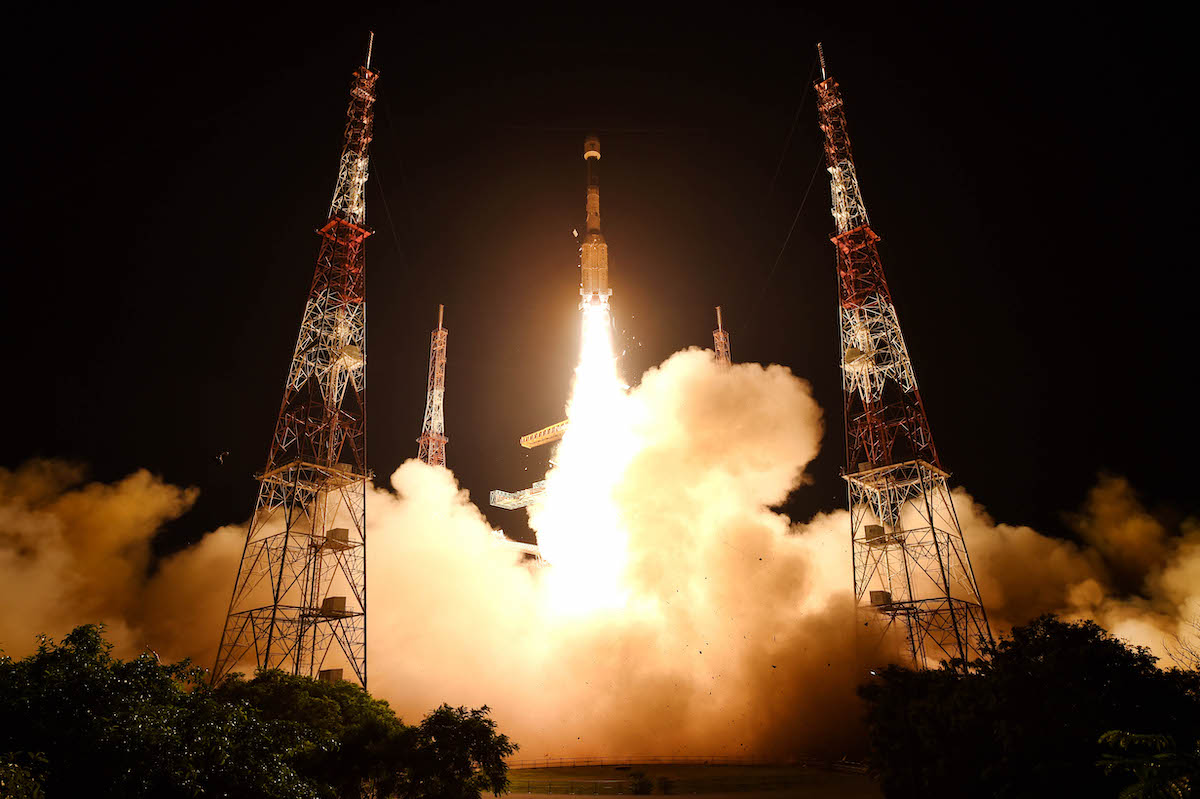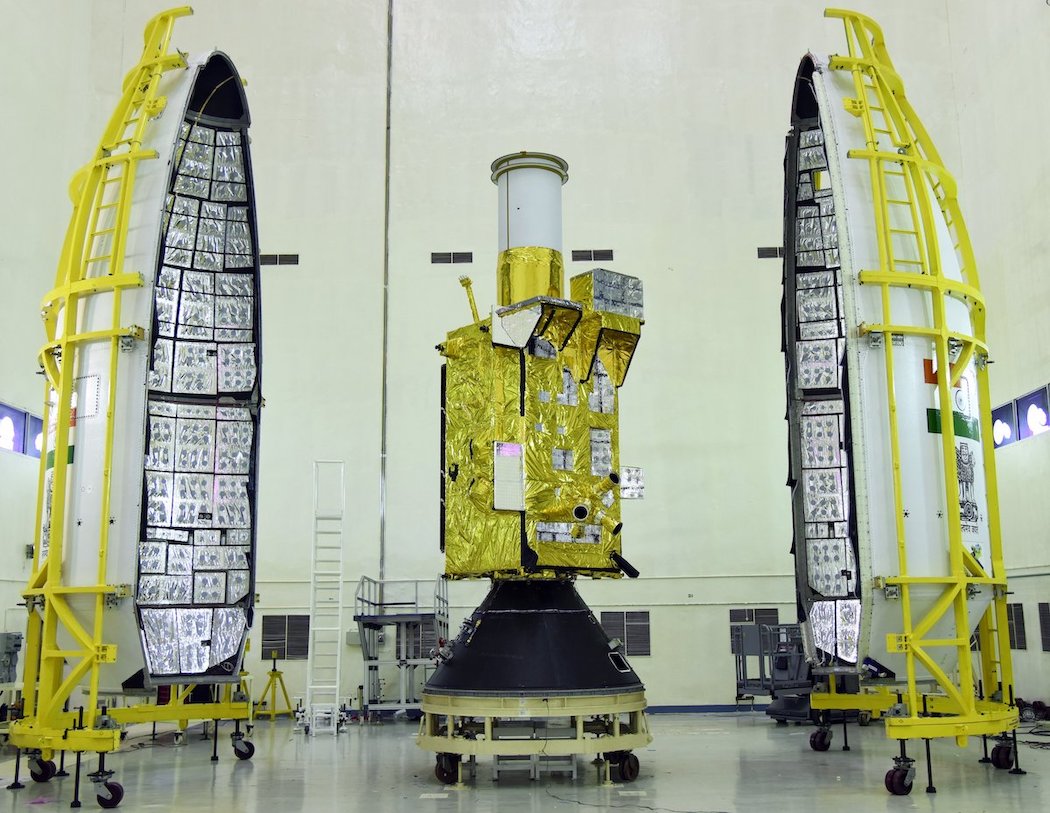
An Indian Geosynchronous Satellite Launch Vehicle tumbled out of control five minutes after liftoff Wednesday when the rocket’s cryogenic upper stage failed to ignite, destroying a long-delayed Earth observation spacecraft and ending a streak of 16 straight successful Indian space launches.
The GSLV Mk.2 rocket and the EOS-03 Earth observation satellite crashed back to Earth after the third stage failure.
The mission lifted off at 8:13 p.m. EDT Wednesday (0013 GMT Thursday) from the Satish Dhawan Space Center on India’s east coast. The launch occurred at 5:43 a.m. Thursday local time in India.
After good performance from the GSLV’s strap-on boosters, first stage, and second stage, the mission ran into trouble when the rocket’s third stage was supposed to take over to accelerate the EOS-03 spacecraft into orbit.
The Indian Space Research Organization said the cryogenic upper stage did not ignite due to a “technical anomaly.”
An animation of the GSLV’s upper stage showed the rocket drifting out of control moments after the hydrogen-fueled engine was expected to ignite about five minutes into the mission. A commentator on ISRO’s live launch webcast announced ignition off the third stage, but officials later said in a statement that the upper stage did not ignite.
“The mission couldn’t be accomplished as intended,” ISRO said in a statement.
Liftoff of India’s GSLV Mk.2 rocket, carrying a sharp-eyed Earth-imaging and disaster monitoring satellite heading for a high-altitude perch in geostationary orbit. https://t.co/ZzsI52qA5G pic.twitter.com/VW5ltcVlYZ
— Spaceflight Now (@SpaceflightNow) August 12, 2021
A plot of the rocket’s altitude and velocity showed the upper stage was not following its planned trajectory. Displays in the launch control center showed the rocket appeared to reach a maximum altitude of about 87 miles (140 kilometers) and a velocity of approximately 10,700 mph (4.8 kilometers per second), well short of the speed required to enter orbit.
The upper stage and the EOS-03 spacecraft fell back into the atmosphere, and any debris that survived re-entry likely fell into the Andaman Sea west of Thailand, according to Jonathan McDowell, an astrophysicist and expert on spaceflight activity.
The GSLV Mk.2 uses a cryogenic third stage fed by super-cold liquid hydrogen and liquid oxygen propellants. The upper stage has a main engine and two vernier steering engines designed to produce around 16,500 pounds of thrust.
The upper stage was expected to fire for 13-and-a-half minutes to place the EOS-03 spacecraft in an elongated geostationary transfer orbit.
The circumstances of the GSLV failure resemble an upper stage malfunction that struck a GSLV mission in April 2010. On that mission, the third stage engine’s fuel turbo pump failed about one second after ignition.
The failure in 2010 occurred on the first test flight of the GSLV Mk.2’s Indian-built cryogenic upper stage, which replaced a Russian third stage engine used on the now-retired GSLV Mk.1 rocket variant.
Four of India’s 14 GSLV Mk.1 and Mk.2 missions have now failed to reach orbit. Another two GSLV flights deployed their payloads in lower-than-planned orbits.
But ISRO strung together a series of six straight successful flights of the GSLV Mk.2 rocket before the failure Wednesday. The failure broke a streak of 16 consecutive successful Indian space launches since 2017, including 14 missions with the GSLV Mk.2 and the smaller Polar Satellite Launch Vehicle, plus two launches of the heavier GSLV Mk.3 based on a different design.
The GSLV appears to have suffered a failure during the burn of its third stage.
The altitude and telemetry trace in mission control has deviated from the flight plan.https://t.co/ZzsI52qA5G pic.twitter.com/pt8XLWkdAq
— Spaceflight Now (@SpaceflightNow) August 12, 2021
Wednesday’s failure continues a turbulent period for India’s space program, which has suffered lengthy launch delays caused by the coronavirus pandemic. India launched just two orbital missions in 2020 after launching six times in 2019. The launch attempt of the EOS-03 satellite was India’s second of this year, following a successful flight of the smaller Polar Satellite Launch Vehicle in February.
Development of India’s Gaganyaan spacecraft for astronaut missions has slowed due to coronavirus-related lockdown restrictions. An unpiloted test flight of the Gaganyaan crew capsule previously scheduled for this year has been delayed to no earlier than mid-2022, followed by a potential astronaut flight in 2023.
The EOS-03 satellite lost Wednesday was fitted with a large telescope to look down on the Indian subcontinent from a geostationary orbit more than 22,000 miles (nearly 36,000 kilometers) over the equator.
The roughly 5,000-pound (2,268-kilogram) spacecraft was formerly named GISAT 1. ISRO renamed the craft EOS-03 under a new naming scheme for the country’s Earth observation satellites.
The satellite’s Earth-viewing telescope was designed to take pictures of the entire Indian subcontinent at half-hour intervals, with the ability to image smaller regions as often as every five minutes. The satellite’s camera was to resolve features as small as 138 feet (42 meters) in its highest resolution mode.
EOS-03’s imaging system was expected to take pictures in visible, near infrared, and shortwave infrared bandwidths, providing insights into the growth and health of crops and forests, changes in bodies of water, snow and ice cover, mineralogy, and the evolution of clouds, storms, and cyclones.
But the satellite’s primary purpose was to serve as a quick-response tool providing near real-time monitoring of natural disasters and other short-term “episodic events,” according to ISRO.

EOS-03 was the first in a series of geostationary Earth-imaging satellites under development in India. China has launched similar sharp-eyed remote sensing satellites into geostationary orbit to image the Asia-Pacific region.
The EOS-03 mission was supposed to launch on March 5, 2020, but ISRO announced the day before liftoff that the launch was postponed due to “technical reasons.” Once engineers resolved the unspecified technical concerns, impacts from the coronavirus pandemic forced significant delays in India’s launch schedule.
The GSLV validated a new payload fairing design before the malfunction on the rocket’s third stage. The wider payload shroud will allow the GSLV Mk.2 to accommodate larger spacecraft, including a joint NASA-ISRO radar imaging satellite scheduled to launch on a GSLV Mk.2 in 2023.
The ogive-shaped fairing, which has a more curved shape than previous GSLV payload fairings, measures about 13 feet (4 meters) in diameter. That’s about 2 feet, or 60 centimeters, wider than the older fairing design.
Email the author.
Follow Stephen Clark on Twitter: @StephenClark1.
